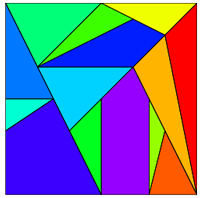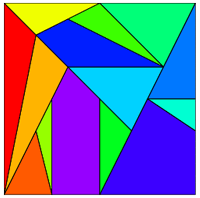2. The branch of discrete mathematics that deals with the study of arrangement of objects into sets, and in particular with two general types of problems: enumeration and existence.
3. The study of the number of ways in which a given problem can be solved.
An example of a very early study of combinatorics is the Stomachion
Stomachion is the name given to an ancient puzzle, or tangram, in one of Archimedes' treatises.
A tangram is a puzzle in which a square is divided into different geometric shapes and, like a jigsaw, must be put back together. In the treatise the square is divided into 11 triangles, two quadrilaterals, and a pentagon. Many assumed that Archimedes simply included it as a challenging game.
On the other hand, there are those who believe that Archimedes might have included the Stomachion to demonstrate multiple solutions to a problem. This suggests that the question Archimedes was tackling was: how many ways are there to complete a square, given the 14 pieces of the puzzle?
The Stomachion is described in fragmentary manuscripts attributed to Archimedes as noted by Magnus Ausonius (310-395 A.D.).
The puzzle is also referred to as the "loculus of Archimedes" (Archimedes' box) or "syntemachion" in Latin texts. The word Stomachion has as its root the Greek word meaning, "stomach."
It should be noted that Ausonius was referring to the figure as the ostomachion, an apparent corruption of the original Greek.


Examples of Stomachion puzzles.
